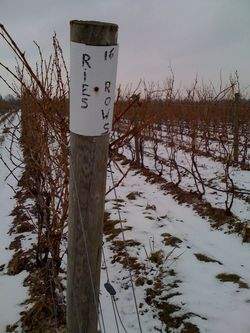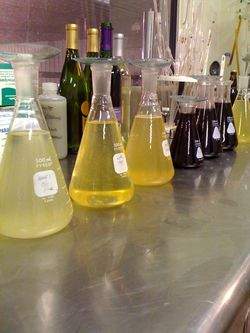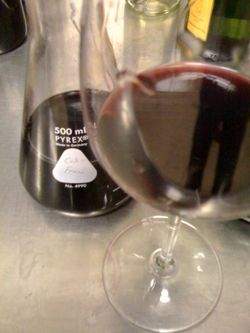By Evan Dawson, Finger Lakes Editor
It's hard to be good at everything. You know your favorite singer? Awful painter. The stud high school quarterback? Horrendous dancer. The world's greatest scientist? World's worst public speaker.
When you understand this idea, you will better understand what makes the vineyard site at White Springs Winery so interesting.
I joined winemaker Derek Wilber (pictured above) there on a blustery winter's day. White Springs sits on the northwest side of Seneca Lake, not far from the town of Geneva. Unlike many Finger Lakes sites, the White Springs vineyard is not very close to the water. Getting there requires a short jog off the main lake road and then a climb up the hillside.
"The farther away you get from the lake, the rockier and more gravelly the soils get," Wilber explained. He told me that, as a general rule, the soils in the Finger Lakes are denser and more clay-based near the water, and tend to get rockier farther up the hillsides. "Clay soils don't drain nearly as well, so if they take a lot of rain, it can be difficult for the fruit," Wilber said. "Our vineyard has extremely good drainage."
He didn't have to explain what that meant for the 2010 vintage. The Finger Lakes enjoyed a gloriously long and warm growing season in 2010, but some isolated spots in the region took a severe rainstorm in September. (Some sites reported several inches in less than 24 hours.) Vineyards like the White Springs site, high on a hill and far from the lake, withstood the pounding rain. "We have an advantage in a vintage like 2010," Wilber said. "This site really takes water well. We can grow extremely ripe and balanced fruit that won't suffer like fruit in some other places."
When we tasted through the 2010 wines, it was clear Wilber was right. More on that later.
But there is always the other side — the star athlete who can't dance, so to speak.
Because the White Springs site is not close to the water, it receives less protection from temperature swings. Frosts can be a problem, and in 2009, they were. "It wasn't a disaster, but that's not the kind of situation we're best suited for," Wilber conceded. "We're a bit more vulnerable. We can get dinged by frost."
The dichotomy is a fascinating look at what some might call "terroir." And in fact, Wilber surprised me by using the word himself. He's even seeking out terroir in separate parcels of the same vineyard.
 "Terroir is absolutely real… as long as we don't go overboard"
"Terroir is absolutely real… as long as we don't go overboard"
Wilber and the White Springs team has been very careful about which varieties to plant in specific parts of the vineyard. We drove out to the very top of the property, a rather flat parcel composed of those gravelly soils. It is here that Wilber decided to plant not just riesling, but riesling for the purpose of making the winery's dry riesling bottling.
"If all that stuff about terroir is true, this should be an ideal site for dry riesling," he told me. "This is where the site is the rockiest, and the fruit that comes from these vines is not as lush. It lends itself to more mineral-driven riesling. Or, I should say that we think it will!"
It's a thoughtful, analytical approach that remains uncommon in the region as a whole. Wilber is almost painfully cordial, almost soft-spoken, and yet his depth of knowledge comes to the surface immediately. He can talk about the science of wine and the theory of wine, and I wanted to know more about his thoughts on the T word.
"I think terroir is absolutely real," he said. "I've seen it. I think site not only matters, but in the Finger Lakes, site tends to make the biggest difference of all. You stop doubting that when you see the same variety in the same conditions making two vastly different wines from neighboring sites. Site is capable of making a bigger difference than even the clone. So yeah, I think it's fair to talk about our terroir."
But then he smiled and added, "As long as we don't go overboard. Those other factors do make a difference that we shouldn't ignore."
There are 40 acres here in total, with 12 planted to riesling, but it remains a young site. The oldest vines on the property were planted in 2003. It will be fun to find out of Wilber's hunches about terroir are proven correct.
"Back in the 1980s, we didn't really know what the hell we were doing."
Back inside the winery, Wilber offered another surprise. The biggest difference in Finger Lakes winemaking in his three decades comes not in the winemaking itself, he said… but in grape growing.
"The vines were so uneven back when I started out," Wilber said. "Back in the 1980s, we didn't really know what the hell we were doing. Winemakers had to deal with poorly ripened grapes on unhealthy vines. The fruit would split. It didn't have nearly enough exposure and canopy management wasn't anywhere near what it is today."
 The 2009 and 2010 vintages are proof, according to Wilber, of just how far Finger Lakes grape growing has come. "If you took the 2009 weather and had it in the 1980s, you'd have unripe, acidic, poorly colored wines. The difference between a good weather year and a bad weather year was huge. Now the difference is much smaller. Even with some frost and a shorter season, we had relatively ripe fruit and high quality wines in 2009."
The 2009 and 2010 vintages are proof, according to Wilber, of just how far Finger Lakes grape growing has come. "If you took the 2009 weather and had it in the 1980s, you'd have unripe, acidic, poorly colored wines. The difference between a good weather year and a bad weather year was huge. Now the difference is much smaller. Even with some frost and a shorter season, we had relatively ripe fruit and high quality wines in 2009."
And how about a vintage like 2010, with warm weather and a short but strong burst of September rain? "2010 was nothing," Wilber mused. "We're excited about it. But I remember 1988, when we had real heavy rains. The delicate varieties went to hell."
Tasting the 2010 White Springs whites — adjusting acid, staying patient
Wilber found it necessary to add acid to many of the 2010 whites, including riesling and gewurztraminer. He's a classic "don't prefer to manipulate but do what you have to do" kind of winemaker.
For example, Wilber prefers to arrest riesling fermentations as close as possible to a balanced wine, instead of fermenting dry and then back-sweetening with bagged sugar. "But it's not always possible to stop it exactly where you want it," he explained.
The White Springs 2009 Gewurztraminer, which we tasted in the winery, is finally opening up and showing very nicely. Conversely, the 2010 Gewurztraminer is very tight and remains a work in progress, with classic gewurz aromatics but a reserved palate. Wilber added acid to this wine, as did many winemakers who waited to pick after the rains.
Like Peter Bell, his colleague up the road at Fox Run, Wilber believes gewurztraminer requires some bottle age before it fully opens. "I wish I could tell you why that is," he said. "But we see it consistently. I don't know if it needs 18 months, but certainly 6 to 12."
The White Springs 2010 Dry Riesling is much more precocious and is showing that focused, almost austere edge that Wilber expects from this planting. It shows a stone core with lime peel nuances.
The winemaker surprised me for a third time on this trip when he explained how White Springs picks its vinifera grapes. "I prefer mechanical harvesters to hand picking," he said. When I pointed out that many of the region's top bottlings come from hand-picked grapes, he replied with a smile, "I've had this debate before. The reason we pick by machine is all about speed. We want the fastest speed from vine to tank we can get. The grapes that are picked by our machines do not turn to mush by any stretch of the imagination. They remain intact and can go from the vine to the tank in three hours. But think about hand picking. You can pick by hand in the morning and have the grapes sitting out and getting warm all afternoon long."
Tasting the 2010 White Springs reds — significant early development
Wilber has a clear target when he makes red wines: He wants round, rich, fruity reds. Recently he began fermenting at cooler temperatures because he thinks it can draw out more fruity aromas. And White Springs is heavily focused on canopy management to reduce the green character that can show up in red wines.
The White Springs 2010 Cabernet Franc is the class of the group, showing serious weight and length already, ending with classic dried tobacco, a Finger Lakes hallmark of the variety. Wilber expressed concern about the oak influence, but I found the soft vanilla edge to be only a mild distraction. He also explained that he decided to co-ferment the alcohol with malolactic because he "didn't want to lose the fruity character." This wine has a high ceiling and will be interesting to watch.
The fourth big surprise of the day came when Wilber explained that he believes cabernet sauvignon can be more consistently ripened than cabernet franc. That puts him in the minority of Finger Lakes winemakers. In fact, as far as I know, it's a minority of one. Regardless, the White Springs 2008 Cabernet Sauvignon (which he was eager to pour) shows much more ripeness than is typical for the variety in this region.
Strangely, Wilber showed far less confidence with his pinot noir. He was refreshingly honest in his skepticism about the variety's potential in the Finger Lakes, but I disagreed with his take.
"I think if Finger Lakes pinot is going to do well, it's got to be fruitier and bigger," he said. In other words, it needs to get darker, more in line with a west coast pinot noir that consumers typically buy. I pointed out that wineries like Heart & Hands and Ravines are making complex pinots that are nevertheless not thick and dark. "I admire what they're doing, but I'm not sure we can make that style work," Wilber said.
When I finally left White Springs, much later than I intended, I recalled his comment about the 1980s. If it's true that growers and producers "didn't know what the hell they were doing" back then, it's equally accurate to say they know exactly what the hell they're doing now. And it's this kind of knowledge-based — even terroir-based! — thinking that could benefit the entire region.


